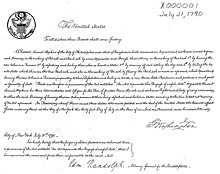Samuel Hopkins (inventor): Difference between revisions
cleanups |
Paynter and the Patent Office have the wrong Samuel Hopkins. The Maxey article sets matters straight Tag: references removed |
||
| Line 1: | Line 1: | ||
[[Image:FirstUSpatent.jpg|thumb|U.S. patent X1]] |
[[Image:FirstUSpatent.jpg|thumb|U.S. patent X1]] |
||
[[Image:Pittsford, Vermont - first US patent.JPG|thumb|Plaque honoring Samuel Hopkins in [[Pittsford, Vermont]]]] |
[[Image:Pittsford, Vermont - first US patent.JPG|thumb|Plaque honoring Samuel Hopkins in [[Pittsford, Vermont]]]] |
||
'''Samuel Hopkins''' (December 9, 1743 – 1818) was an [[United States|American]] [[inventor]] from [[Philadelphia, Pennsylvania]],<ref |
'''Samuel Hopkins''' (December 9, 1743 – 1818) was an [[United States|American]] [[inventor]] from [[Philadelphia, Pennsylvania]],<ref Maxey, "Samuel Hopkins, The Holder of the First Patent," 122 Pennsylvania Magazine of History and Biography (no. 1, 1998), 3-38. On July 31, 1790, he was granted the first U.S. [[patent]], under the new U.S. patent statute just signed into law by President Washington on April 10, 1790. Hopkins had petitioned for a patent on an improvement "in the making of [[Potash|Pot ash]] and [[Pearlash|Pearl ash]] by a new Apparatus and Process."<ref>{{cite web |url=http://www.uspto.gov/web/offices/ac/ahrpa/opa/kids/kidevents_press.html#x1 |title=Kids - Time Machine - Historic Press Releases - USPTO |publisher=United States Patent and Trademark Office}}</ref> |
||
The statute did not create a [[United States Patent and Trademark Office|Patent Office]]. Instead a committee of the [[United States Secretary of State|Secretary of State]], [[United States Secretary of War|Secretary of War]] and the [[United States Attorney General|Attorney General]] were authorized to make a decision on the merit of a properly documented petition. |
The statute did not create a [[United States Patent and Trademark Office|Patent Office]]. Instead a committee of the [[United States Secretary of State|Secretary of State]], [[United States Secretary of War|Secretary of War]] and the [[United States Attorney General|Attorney General]] were authorized to make a decision on the merit of a properly documented petition. |
||
| Line 12: | Line 12: | ||
Samuel Hopkins, the second child of [[Quaker]] parents, was born just north of [[Baltimore, Maryland]]. At about the age of 16, he was apprenticed to Robert Parrish, a Quaker tradesman in Philadelphia. In the spring of 1765, Hopkins married Parrish's sister-in-law, Hannah Wilson, and together they raised six children in Philadelphia. |
Samuel Hopkins, the second child of [[Quaker]] parents, was born just north of [[Baltimore, Maryland]]. At about the age of 16, he was apprenticed to Robert Parrish, a Quaker tradesman in Philadelphia. In the spring of 1765, Hopkins married Parrish's sister-in-law, Hannah Wilson, and together they raised six children in Philadelphia. |
||
The 1790 [[U.S. Census]] listed Hopkins's occupation as "Pott Ash Maker". The city directories of the period listed him as a "pot-ash maker" and a "pot-ash manufacturer". |
|||
Around 1800, for financial reasons, he and his wife moved briefly to [[Rahway, New Jersey]], to live with their daughter Sarah and son-in-law William Shotwell. They returned to Philadelphia sometime before Hopkins's death in 1818. |
Around 1800, for financial reasons, he and his wife moved briefly to [[Rahway, New Jersey]], to live with their daughter Sarah and son-in-law William Shotwell. They returned to Philadelphia sometime before Hopkins's death in 1818. |
||
Revision as of 19:52, 26 July 2010


Samuel Hopkins (December 9, 1743 – 1818) was an American inventor from Philadelphia, Pennsylvania,Cite error: The <ref> tag has too many names (see the help page).
The statute did not create a Patent Office. Instead a committee of the Secretary of State, Secretary of War and the Attorney General were authorized to make a decision on the merit of a properly documented petition.
The patent was signed by President George Washington, Attorney General Edmund Randolph, and Secretary of State Thomas Jefferson. The other U.S. patents issued that year were for a new candle-making process and Oliver Evans's flour-milling machinery.
Hopkins also received the first "Canadian" patent from the Parliament of Lower Canada in 1791, issued "by the Governor General in Council to Angus MacDonnel, a Scottish soldier garrisoned at Quebec City, and to Samuel Hopkins, a Vermonter, for processes to make potash and soap from wood ash." [1][2][3]
Personal details
Samuel Hopkins, the second child of Quaker parents, was born just north of Baltimore, Maryland. At about the age of 16, he was apprenticed to Robert Parrish, a Quaker tradesman in Philadelphia. In the spring of 1765, Hopkins married Parrish's sister-in-law, Hannah Wilson, and together they raised six children in Philadelphia.
The 1790 U.S. Census listed Hopkins's occupation as "Pott Ash Maker". The city directories of the period listed him as a "pot-ash maker" and a "pot-ash manufacturer".
Around 1800, for financial reasons, he and his wife moved briefly to Rahway, New Jersey, to live with their daughter Sarah and son-in-law William Shotwell. They returned to Philadelphia sometime before Hopkins's death in 1818.
References
- ^ "Learn and Discover: Famous Canadian Patents". Canadian Intellectual Property Office. 2006-11-07. Archived from the original on 2007-02-16.
- ^ Duy, Vic (2001). "A Brief History of the Canadian Patent System" (PDF). Canadian Biotechnology Advisory Committee.
{{cite web}}: Unknown parameter|month=ignored (help) - ^ White, Michael (January 07, 2007). "Greatest Canadian Invention: Insulin". The Patent Librarian's Notebook.
{{cite web}}: Check date values in:|date=(help)
